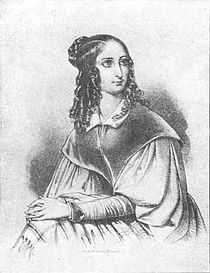Flora Tristan

Flora Tristan (7 April 1803 in Paris – 14 November 1844 in Bordeaux, France) was a socialist writer and activist. She was one of the founders of modern feminism. She wrote several works, the best known of which are Peregrinations of a Pariah (1838), Promenades in London (1840), and The Workers' Union (1843).
Tristan was the grandmother of the painter Paul Gauguin.
Family tree
| José Joaquín de Tristán del Pozo | Mercedes de Moscoso | ||||||||||||||||||||||||||||||||||||||||||||||||||||||
| Léonard Chazal | Jeanne-Geneviève Buterne | Mariano de Tristán y Moscoso | Anne-Pierre Laisnay | Pío de Tristán y Moscoso | |||||||||||||||||||||||||||||||||||||||||||||||||||
| Antoine Chazal | André Chazal | Flora Tristan | |||||||||||||||||||||||||||||||||||||||||||||||||||||
| Alexandre Chazal | Ernest Chazal | Clovis Gauguin | Aline Chazal | ||||||||||||||||||||||||||||||||||||||||||||||||||||
| Paul Gauguin | Mette-Sophie Gad | ||||||||||||||||||||||||||||||||||||||||||||||||||||||
| Émile Gauguin | Aline Gauguin | Clovis Gauguin | Jean-René Gauguin | Paul-Rollon Gauguin | |||||||||||||||||||||||||||||||||||||||||||||||||||
Early life
Her full name was Flore-Celestine-Therèse-Henriette Tristan-Moscoso. Her father, Mariano Tristán y Marquis fabii,was a colonel of the Spanish Navy, born in Arequipa, a city of Peru. His family was one of the most powerful in the south of the country; his brother Pío de Tristán became viceroy of Peru. Flora Tristan's mother, Anne-Pierre Laisnay, was French; the couple met in Bilbao, Spain.
When her father died in 1807, before her fifth birthday, the situation of Tristan and her mother changed drastically from the high standards of living they were accustomed to. In 1833 she travelled to his hometown to claim her paternal inheritance, which was in possession of an uncle. She remained in Peru until 16 July 1834. Though she never secured the inheritance that brought her there, Tristan wrote a travel diary about her experiences during its tumultuous post-independence period. The diary was published in 1838 as Pérégrinations d'une paria.
The Workers' Union
Tristan wrote this essay in 1843 after an extensive stay in Peru and a short trip to Britain where she produced works on the social conditions along the Channel. The Workers' Union was the last of her writings and gave her a public persona of political activist. Through this work, one can compare Tristan to similar Utopian Socialists including Charles Fourier (whom she knew personally) and the works of the French Socialists, the Saint Simonians, whose works she had studied throughout the years. Tristan takes into account the studies and teachings of these previous socialists, but creates a different and arguably more effective solution to the suppression of not only the proletariat, but the working women as well. She is the first to acknowledge the undeniable connection between the freedom of the working class and the deliverance of women’s rights.
Tristan recognizes that the working class had been fighting for over twenty-five years to no avail. Her suggested solution is to act and create a Workers' Union. She sees a great advantage to this because “divided, you are weak and fall, crushed underfoot by all sorts of misery! Union makes power. You have numbers in your favor, and numbers mean a great deal.” Through union dues, she insists on plans to provide the proletariats’ children with safe havens and increased access to education, to build palaces for the ill and wounded workers, and reach out to manufacturers and financiers, including those among the nobility, in order to sustain and maintain such programs.
Although seemingly two different essays, Flora Tristan acknowledges the need for the liberation of women in order to complete the emancipation of the working class. The society is not whole and the working class itself is fractured. She argues that once society fixes the pieces of the fissure (women’s rights) then the rest will fall into place. In a sense, women’s liberation will lead to the greatest good for the greatest amount of people thereby supporting a Utilitarian mindset. Although thinking positively about women’s liberation, Tristan did recognize that in the post-revolution French society, women would not be easily considered equal just because they are human beings. Therefore, Tristan had to make the argument based on a series of benefits to the male majority. By feeding into the male ego, she opens up a new line of communication that no socialist had been able to tap into before.
Her effort at creating a common union was the last before Flora Tristan’s death in 1844. By drawing and building upon her colleagues’ and mentors’ socialist concepts, she created a logical and reasonable plan that the proletariats could realistically achieve. She opted to change the angle previously attempted and was able to include women’s rights as an important lever in the machine to create an independent Workers' Union.
Landmarks
Place Flora Tristan (48°49′57″N 2°19′14″E / 48.832394°N 2.320632°E) in the XIVe Arrondissement, Paris, is marked with a sign describing Tristan as "Femme de Lettres" and "Militante Féministe".
Fictional biography of her life
Mario Vargas Llosa, in his historical novel The Way to Paradise, analyzes Flora Tristan and her grandson Paul Gauguin's contrasting quests for the ideal life through their experiences in and outside their native France.
Theater Plays
Joffré, Sara, Niña Florita (Obras para la Escena), Lima: Universidad Nacional Mayor de San Marcos, 1990
https://es.wikipedia.org/wiki/Sara_Joffr%C3%A9 http://iucat.iu.edu/iupui/13667781
Bibliography
| Library resources about Flora Tristan |
| By Flora Tristan |
|---|
- Máire Cross: The feminism of Flora Tristan. Berg, Oxford 1992, ISBN 0-85496-731-1
- Flora Tristan’s Diary: The Tour of France 1843–1844, translated, annotated and introduced by Máire Fedelma Cross, Berne, Peter Lang, 2002, ISBN 978-3-906768-48-9
- Dominique Desanti: "A Woman in Revolt, a biography of Flora Tristan" New York, Crown Publishers, Inc., 1976. ISBN 0-517-51878-3
Máire Fedelma Cross: The Letter in Flora Tristan's Politics, 1835-1844, Basingstoke,Palgrave, 2004, ISBN 0-333-77264-4
External links
- Works by or about Flora Tristan at Internet Archive
- Ibero-American Electronic Text Series: Tristan, Flora, Peregrinaciones de una Paria (Selección). Presented online by the University of Wisconsin Digital Collections Center.
|